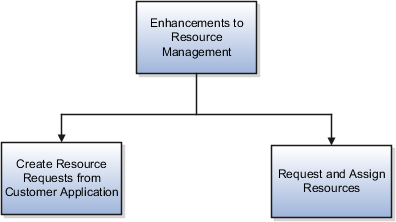Project Requirements
If you manage projects using the Agile development method, you start by identifying the high-level requirements and separating them further to manage the completion of work on the requirement.
You use the Project Requirements work area to:
-
Organize backlog items by requirements
-
Manage your list of backlog items
-
Create project tasks for backlog items
Build a Requirement Hierarchy
You can organize requirements into a hierarchy and split them into lower-level requirements. You can finally break them down into backlog items. Use the requirement hierarchy to manage the work that must be completed to fulfill the requirement.
You can view and create backlog items at any level of the hierarchy and also search for requirements and backlog items.
The following example shows a simple two-level requirement hierarchy. You can break down the top-level requirement, enhancements to resource management into:
-
Create resource requests
-
Request and assign resources

Manage Backlog Items
You can split requirements into backlog items and associate them to the lowest-level of the hierarchy. Backlog items represent a list of incremental work that must be done to meet a requirement.
Do the following to use backlog items to track product development:
-
Assign ownership of backlog items to scrum masters and product owners.
-
Rank and prioritize backlog items.
-
Capture user stories and acceptance criteria for a backlog item.
-
Create tasks and capture task details such as resource, task dates, and effort.
-
Associate deliverables with backlog items.
Associate Projects and Tasks to Track Work
You can associate your projects with backlog items to track the completion of work on a requirement. Associate projects to backlog items by selecting a project from the list in the Project Name column. If the project doesn't exist, you can also create a project using the Create link in the Project Name column on the Manage Backlog Items page.
After you associate a backlog item to a project, you can use the Tasks tab in the Backlog Item Details region to create project tasks for each backlog item.